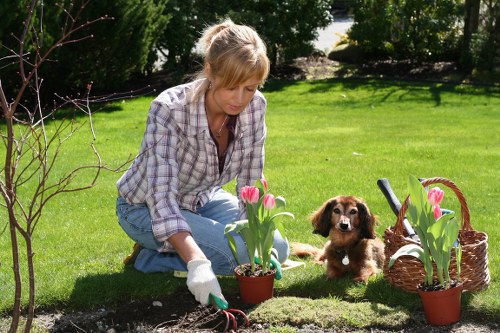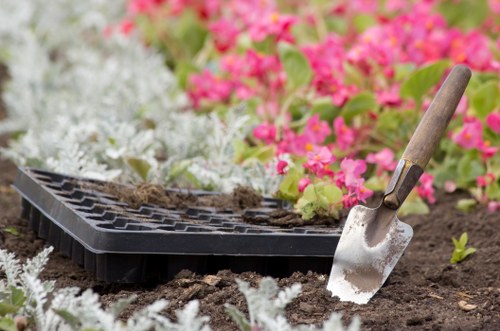Mastering Hedge Trimming in Lee: A Comprehensive Guide
Introduction to Hedge Trimming

Maintaining a beautiful garden often starts with the meticulous care of hedges. Hedge trimming in Lee is an essential task that not only enhances the aesthetic appeal of your property but also promotes the health and longevity of your plants.
Proper hedge trimming requires knowledge of different techniques, the right tools, and an understanding of plant biology. Whether you’re a homeowner looking to keep your garden pristine or a professional landscaper in Lee, mastering hedge trimming can lead to stunning results.
In this guide, we’ll explore the best practices for hedge trimming, the tools you’ll need, and tips to achieve the perfect shape and health for your hedges.
Why Regular Hedge Trimming is Important

Regular hedge trimming plays a pivotal role in maintaining the structure and appearance of your hedges. It helps in controlling the growth, preventing overgrowth, and promoting dense foliage.
Trimming hedges also reduces the risk of pest infestations and diseases by removing dead or diseased branches. This not only keeps your garden healthy but also ensures that your hedges remain a vibrant part of your landscape.
Additionally, well-trimmed hedges can serve as natural privacy screens, enhancing the overall ambiance of your outdoor space.
Choosing the Right Tools for Hedge Trimming

Equipping yourself with the right tools is crucial for effective hedge trimming in Lee. The choice of tools depends on the type and size of hedges you’re working with.
- Pruning Shears: Ideal for small, delicate hedges.
- Electric Hedge Trimmers: Suitable for medium-sized hedges, offering efficiency and precision.
- Manual Hedge Saws: Best for larger hedges that require more cutting power.
- Loppers: Perfect for thick branches that need to be trimmed.
Using the right tool not only makes the trimming process easier but also ensures that your hedges are cut cleanly, promoting faster healing and growth.
Step-by-Step Guide to Trimming Your Hedges

1. Assess Your Hedges
Before you begin trimming, take the time to assess the current state of your hedges. Look for any signs of disease, dead branches, or areas that need extra attention.
2. Gather Your Tools
Ensure you have all the necessary tools within reach. This includes your chosen trimmers, gloves, safety goggles, and a sturdy ladder if needed.
3. Start Trimming
Begin by trimming the sides of the hedge, following a natural shape. Avoid cutting too much at once; it’s better to trim gradually over several sessions.
Best Practices for Maintaining Healthy Hedges

To keep your hedges healthy and lush, follow these best practices:
- Regular Trimming: Trim your hedges at least twice a year to maintain their shape and prevent overgrowth.
- Proper Timing: The best times for trimming are late spring and early autumn when the plants are actively growing.
- Clean Tools: Always use clean, sharp tools to make precise cuts and reduce the risk of disease transmission.
- Balanced Cuts: Ensure that you trim evenly on all sides to promote balanced growth.
- Watering and Fertilizing: Provide adequate water and nutrients to your hedges to support healthy growth.
Implementing these practices will ensure that your hedges remain robust and attractive throughout the year.
Common Mistakes to Avoid
When it comes to hedge trimming in Lee, there are several common mistakes that can hinder the health and appearance of your hedges:
- Over-Trimming: Cutting too much at once can stress the plant and lead to weak growth.
- Ignoring Plant Type: Different hedges require different trimming techniques. Research your specific hedge type before trimming.
- Using Dull Tools: Dull blades can cause ragged cuts, increasing the risk of disease.
- Neglecting Safety: Always prioritize safety by wearing protective gear and using tools correctly.
By avoiding these mistakes, you can maintain the health and elegance of your hedges effectively.
Hiring Professional Hedge Trimming Services
If the task seems daunting or you prefer professional results, consider hiring a hedge trimming service in Lee. Professionals have the expertise and equipment to handle any hedge type, ensuring precise and efficient trimming.
Benefits of hiring professionals include:
- Expertise: Knowledgeable in various trimming techniques suitable for different hedge types.
- Efficiency: Equipped with commercial-grade tools for faster and more effective trimming.
- Safety: Trained to handle tools safely, reducing the risk of accidents.
- Convenience: Saves you time and effort, allowing you to focus on other tasks.
If you decide to go this route, ensure you choose a reputable service provider with positive reviews and a portfolio of completed projects.
Seasonal Hedge Trimming Tips
Spring Trimming
Spring is an excellent time for hedge trimming, as it encourages new growth and helps shape the plants after winter.
Summer Trimming
In summer, focus on light trimming to maintain the shape without stressing the plants during the hottest months.
Autumn Trimming
Autumn trimming prepares hedges for the winter, removing any weak or damaged branches that could be affected by cold weather.
Tools Maintenance for Longevity
Maintaining your hedge trimming tools is essential for achieving the best results and ensuring their longevity.
- Cleaning: After each use, clean your tools to remove sap, dirt, and debris.
- Sharpening: Regularly sharpen blades to maintain cutting efficiency.
- Lubrication: Apply oil to moving parts to prevent rust and ensure smooth operation.
- Storage: Store tools in a dry, safe place to protect them from the elements.
Proper maintenance not only extends the life of your tools but also ensures that each trimming session is effective and precise.
Eco-Friendly Trimming Practices
Adopting eco-friendly practices in hedge trimming not only benefits your garden but also the environment.
Using Manual Tools
Whenever possible, use manual trimming tools like hand shears or loppers to reduce carbon emissions associated with electric or gas-powered tools.
Composting Clippings
Instead of disposing of hedge clippings, consider composting them to enrich your garden soil naturally.
Water Conservation
Trim hedges during cooler parts of the day to minimize water loss through evaporation, and ensure they are adequately watered after trimming.
Innovative Hedge Trimming Techniques
Staying updated with the latest trimming techniques can help you achieve better results and keep your hedges looking their best.
Topiary Trimming
Topiary involves shaping hedges into artistic forms, adding a unique touch to your garden landscape.
Noise-Reduction Trimming
For hedges near busy streets, trimming to create denser foliage can help reduce noise pollution.
Sunlight Maximization
Strategically trimming hedges to allow more sunlight to reach your plants can promote healthier growth.
Choosing the Right Hedge Plants for Lee’s Climate
Selecting hedge plants that thrive in Lee’s climate ensures that your hedges remain healthy with minimal maintenance.
- Boxwood: Known for its versatility and dense foliage, ideal for formal hedges.
- Privet: Fast-growing and hardy, suitable for creating privacy screens.
- Holly: Evergreen with vibrant berries, adding color and texture to your garden.
- Laurel: Thick and lush, perfect for sound barriers and privacy.
Consult with local nurseries or landscaping experts to choose the best hedge plants that suit your specific needs and Lee’s environmental conditions.
Advanced Hedge Trimming Tools
For those looking to take hedge trimming to the next level, investing in advanced tools can make a significant difference.
Battery-Powered Trimmers
Battery-powered hedge trimmers offer portability and power without the noise and emissions of gas-powered tools.
Automatic Trimming Systems
Automated trimming systems can maintain large or complex hedges with minimal manual effort, perfect for expansive gardens.
Smart Trimming Tools
Incorporate technology with smart trimming tools that provide precision cutting and track trimming patterns for consistent results.
Cost Considerations for Hedge Trimming
Understanding the costs associated with hedge trimming helps in budgeting and making informed decisions.
- DIY Trimming: Initial investment in tools can be higher, but long-term costs are lower as you handle maintenance yourself.
- Professional Services: Costs vary based on hedge size, complexity, and frequency of service.
- Tool Maintenance: Ongoing costs for maintaining and replacing tools as needed.
Evaluate your budget and needs to decide whether to trim hedges yourself or hire professionals for the best balance of cost and quality.
Conclusion
Mastering hedge trimming in Lee involves understanding the techniques, using the right tools, and maintaining your hedges regularly. Whether you choose to tackle the task yourself or hire professionals, the key is consistent care and attention to detail.
By following the guidelines outlined in this article, you can ensure that your hedges remain healthy, attractive, and a standout feature of your garden. Contact us today to book your hedge trimming service and give your garden the care it deserves!